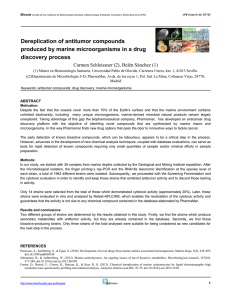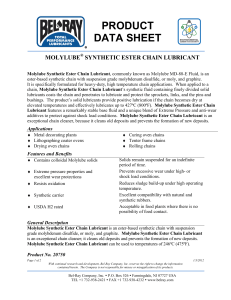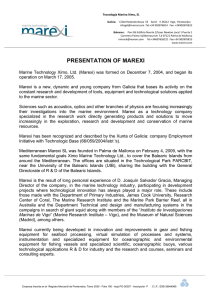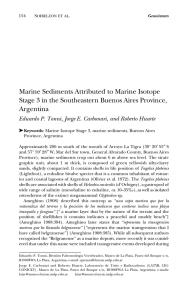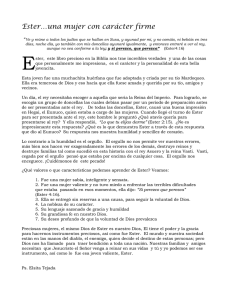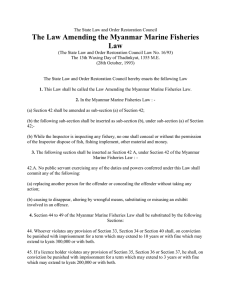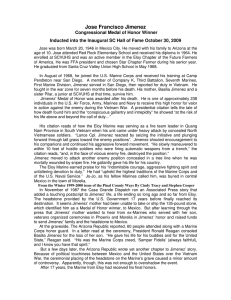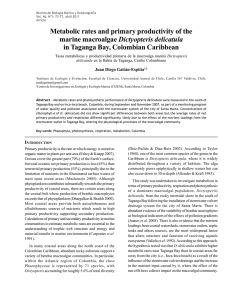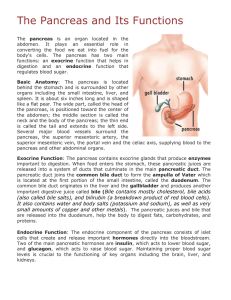Screening and its potential application of lipolytic activity from a marine environment: characterization of a novel esterase from Yarrowia lipolytica CL180
Anuncio
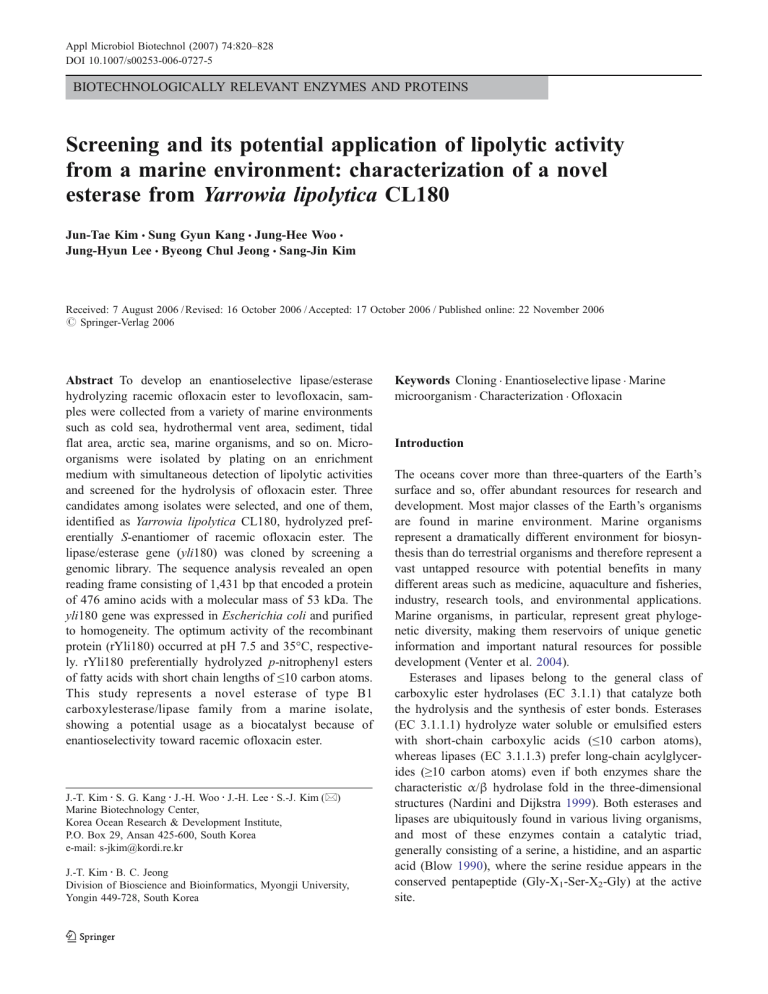
Appl Microbiol Biotechnol (2007) 74:820–828 DOI 10.1007/s00253-006-0727-5 BIOTECHNOLOGICALLY RELEVANT ENZYMES AND PROTEINS Screening and its potential application of lipolytic activity from a marine environment: characterization of a novel esterase from Yarrowia lipolytica CL180 Jun-Tae Kim & Sung Gyun Kang & Jung-Hee Woo & Jung-Hyun Lee & Byeong Chul Jeong & Sang-Jin Kim Received: 7 August 2006 / Revised: 16 October 2006 / Accepted: 17 October 2006 / Published online: 22 November 2006 # Springer-Verlag 2006 Abstract To develop an enantioselective lipase/esterase hydrolyzing racemic ofloxacin ester to levofloxacin, samples were collected from a variety of marine environments such as cold sea, hydrothermal vent area, sediment, tidal flat area, arctic sea, marine organisms, and so on. Microorganisms were isolated by plating on an enrichment medium with simultaneous detection of lipolytic activities and screened for the hydrolysis of ofloxacin ester. Three candidates among isolates were selected, and one of them, identified as Yarrowia lipolytica CL180, hydrolyzed preferentially S-enantiomer of racemic ofloxacin ester. The lipase/esterase gene (yli180) was cloned by screening a genomic library. The sequence analysis revealed an open reading frame consisting of 1,431 bp that encoded a protein of 476 amino acids with a molecular mass of 53 kDa. The yli180 gene was expressed in Escherichia coli and purified to homogeneity. The optimum activity of the recombinant protein (rYli180) occurred at pH 7.5 and 35°C, respectively. rYli180 preferentially hydrolyzed p-nitrophenyl esters of fatty acids with short chain lengths of ≤10 carbon atoms. This study represents a novel esterase of type B1 carboxylesterase/lipase family from a marine isolate, showing a potential usage as a biocatalyst because of enantioselectivity toward racemic ofloxacin ester. J.-T. Kim : S. G. Kang : J.-H. Woo : J.-H. Lee : S.-J. Kim (*) Marine Biotechnology Center, Korea Ocean Research & Development Institute, P.O. Box 29, Ansan 425-600, South Korea e-mail: s-jkim@kordi.re.kr J.-T. Kim : B. C. Jeong Division of Bioscience and Bioinformatics, Myongji University, Yongin 449-728, South Korea Keywords Cloning . Enantioselective lipase . Marine microorganism . Characterization . Ofloxacin Introduction The oceans cover more than three-quarters of the Earth’s surface and so, offer abundant resources for research and development. Most major classes of the Earth’s organisms are found in marine environment. Marine organisms represent a dramatically different environment for biosynthesis than do terrestrial organisms and therefore represent a vast untapped resource with potential benefits in many different areas such as medicine, aquaculture and fisheries, industry, research tools, and environmental applications. Marine organisms, in particular, represent great phylogenetic diversity, making them reservoirs of unique genetic information and important natural resources for possible development (Venter et al. 2004). Esterases and lipases belong to the general class of carboxylic ester hydrolases (EC 3.1.1) that catalyze both the hydrolysis and the synthesis of ester bonds. Esterases (EC 3.1.1.1) hydrolyze water soluble or emulsified esters with short-chain carboxylic acids (≤10 carbon atoms), whereas lipases (EC 3.1.1.3) prefer long-chain acylglycerides (≥10 carbon atoms) even if both enzymes share the characteristic α/β hydrolase fold in the three-dimensional structures (Nardini and Dijkstra 1999). Both esterases and lipases are ubiquitously found in various living organisms, and most of these enzymes contain a catalytic triad, generally consisting of a serine, a histidine, and an aspartic acid (Blow 1990), where the serine residue appears in the conserved pentapeptide (Gly-X1-Ser-X2-Gly) at the active site. Appl Microbiol Biotechnol (2007) 74:820–828 Esterases and lipases are currently used in a broad array of industrial applications, such as organic chemical processing, detergent formulations, synthesis of biosurfactants, the oleochemical industry, the dairy industry, the agrochemical industry, paper manufacture, nutrition, cosmetics, and pharmaceutical processing (Jaeger et al. 1999; Jaeger and Eggert 2002; Pandey et al. 1999; Sharma et al. 2001), because of exquisite chemoselectivity, regioselectivity, no cofactor required, and so on. These properties make them not only a very important class of enzymes for a variety of biotechnological applications but also used as a group of biocatalysts in organic chemistry (Jaeger and Reetz 2000; Schmid and Verger 1998). Many chiral drugs are used to be administered as a racemic mixture that might disturb other biological processes and might cause catastrophic side effects (Li and Grant 1997). Due to the problem of the racemic mixtures, the pharmaceutical industry’s interest subsequently shifted to the production of single enantiomer drugs. In recent years, the preparation of enantiomerically pure drugs through enzymatic resolution of enantiomers has been a subject of increasing interest for pharmaceutical products (Margolin 1993) and is rapidly growing. Ofloxacin developed as a highly active quinolone compound is one example of the shift. Levofloxacin, S-isomer of ofloxacin, shows a broad spectrum of antibacterial activity against both gram-positive and gram-negative bacteria and is generally twice as potent as racemic ofloxacin (Eliopoulos et al. 1996; Schaeffer 2002; Une et al. 1988). The antibacterial activity of levofloxacin is 8 to 128 times greater than that of the corresponding R-isomer (Fujimoto and Mitsuhashi 1990; Hayakawa et al. 1986). The preparation of levofloxacin through chiral resolution has been on demand by an enzymatic or chemical resolution. In this study, we present the screening, cloning, overexpression, and biochemical characterization of a novel esterase from Yarrowia lipolytica CL180. In addition, we examined the enantioselective resolution of racemic ofloxacin ester using the recombinant enzyme. Materials and methods Isolation of marine microorganisms and screening a lipase/ esterase activity For screening enantioselective lipases/ esterases, samples were collected from various marine environments: marine sediments from Edison Seamount (south of Lihir Island, Papua New Guinea; depth, 1440 m; 3°89′S, 152°49′E), Barents Sea (north of Russia; depth, 128.5 m; 72°00′N, 49°00′E), East Sea (Sea of Japan, Ulleungdo of Korea; depth, 758.7 m; 38°00′N, 131°27′E), and Gwangyang Bay (Gwangyang of Korea); sponges and seaweeds from the south sea (Sea of Japan, Geomundo of 821 Korea; depth, 12 m; 34°04′N, 127°15′E), west sea (East China Sea, Yongjongdo of Korea; depth, 0 m; 37°27′N, 126°21′E), and east sea (Sea of Japan, Hujin of Korea; depth, 0 m; 37°8′N, 129°4′E); and oil-contaminated soil samples and sludges from Panweol (Ansan City of Korea) as described in Tables 1 and 2. Samples were collected under formal agreement with all legal parties. Immediately after sampling, 0.3 g of individual samples were ground in a mortar containing 3-ml sterile seawater, and a 100-μl aliquot was spread onto agar plates of marine agar 2216 (Difco, Detroit, MI, USA) containing 1% tributyrin (TBN) as a substrate. The isolates were systematically deposited in Korea Ocean Research & Development Institute culture collection, and 16S rRNA gene was amplified from genomic DNA by polymerase chain reaction (PCR) using the bacterial primers forward primer 27F (5′-AGAGTTTGATCATGGCTCAG-3′) and reverse primer 1518R (5′-AAGGAGGTGATCCAGCCGCA-3′) followed by DNA sequencing using 518R primer (5′GTATTACCGCGGCTGCTGG-3′) to analyze the microbial composition of collected samples. The strains showing a clear zone on TBN agar plate were subcultured and inoculated into a 100-ml baffled Erlenmeyer flask containing 30 ml of marine broth 2216 (Difco). After incubation at 30°C for 24 h, the cells were harvested by centrifugation at 5,000×g for 20 min and washed twice with 50 mM trishydroxymethylaminomethane (Tris)–HCl buffer (pH 7.5). Then, to determine the hydrolyzing activity toward p-nitrophenyl ofloxacin, 1 g (wet weight) of the cells harvested was added to 50 mM Tris–HCl buffer (pH 7.5) containing 0.1 mM p-nitrophenyl ofloxacin (EnzyChem, Korea), and incubated at 30°C for 10 min. The hydrolyzing activity was determined as described in enzyme assays section. To check the enantioselective hydrolysis of ofloxacin ester, 10 g (wet weight) of the cells harvested from 2-l culture on marine broth 2216 (Difco) was added to 100 mM sodium phosphate buffer (pH 6.8) containing 10 mM racemic ofloxacin propyl ester (EnzyChem). After incubation at 30°C for 48 h, the reaction was stopped by heating the solution at 100°C for 10 min or addition of one volume of methanol. Then, the supernatant of the reaction mixture was analyzed by high performance liquid chromatography (HPLC; Hewlett Packard-Model 1050 HPLC system, Hewlett-Packard, Avondale, PA). Preparation of genomic library and screening DNA manipulations were performed by standard procedures, as described by Sambrook and Russell (2001). Genomic DNA from Y. lipolytica CL180 was manually extracted as follows: the cells harvested from 5 ml of overnight culture were vortexed with glass beads in a lysis buffer for 2 min. The supernatant was recovered and 275 μl of 7 M 822 Appl Microbiol Biotechnol (2007) 74:820–828 Table 1 Summary of the isolation of marine microorganisms and the screening of an ofloxacin ester-enantioselective esterase from various marine environments Sampling sites Samples Edison Seamount, Papua New Guinea Barents Sea, Russia (Barents) Ulleungdo, Korea Gwangyang Bay, Korea Geomundo, Korea Yongjongdo, Korea Hujin, Korea Panweol, Korea No. of total isolates Isolates showing a clear zone on TBN plate Number % In total isolates No. of PNPOhydrolyzing isolates No. of enantioselective ofloxacin esterhydrolyzing isolates Sediments ND 30 ND – – Sediments 199 14 7 1 – Sediments Sediments Sponges/seaweeds Sponges/seaweeds Sponges/seaweeds Oil field/sludge 105 ND 439 ND 245 ND 9 19 44 1 29 5 8.6 ND 10 ND 11.8 ND – – 1 – – 1 – – – – – 1 PNPO p-Nitrophenyl ofloxacin; ND not determined ammonium acetate (pH 7.0) was added. After incubation at 65°C for 5 min, the sample was placed into an ice for another 5 min. Then 500 μl chloroform was added, and the sample was centrifuged at 22,000×g at 4°C for 2 min. The supernatant containing the DNA was precipitated with 1 ml isopropanol at −20°C. The pellet was washed with 70% (vol/vol) ethanol, dried, and resuspended in 50 μl Tris– ethylenediaminetetraacetic acid (TE) buffer (pH 8.0). The isolated DNA randomly sheared by nebulization, performed as follows: 20 μg of DNA was mixed into 750 μl of shearing buffer (TE buffer [pH 8.0], containing 10% glycerol) and then placed into a nebulizer (Invitrogen). The nebulizer was then placed into an ice-water bath, and the solution was nebulized using nitrogen gas. To obtain DNA fragments of 2–5 kb in size, the nebulization was performed at 10 pounds per square inch for 40 s. After nebulization, the DNA fragments of 2 to 5 kb in size were isolated from a 0.6% low melting temperature agarose (FMC Seaplaque) gel and end-repaired to generate blunt ends. The blunt-ended DNA was ligated to the HincII site of pUC118 (Takara), and the ligates were introduced into E. coli DH5α. The E. coli transformants were plated onto Luria–Bertani (LB) agar plates containing 100 μg/ml of ampicillin, 1% TBN, 0.1 mM isopropyl-β-D-thiogalactopyranoside (IPTG), and 50 μg/ml 5-bromo-4-chloro-3indolyl-β-D-galactopyranoside (X-gal). After incubation at 37°C for 24 h, a colony with white color and a clear halo was selected. The candidates were tested for the enantioselectivity toward racemic ofloxacin propyl ester as described above, and the clone was analyzed. Table 2 Taxonomic group for the microbial isolates from four sampling sites based on the analysis of the partial sequencing of the 16S rRNA gene DNA sequencing and sequence analysis DNA sequencing was performed by the dideoxy chain termination method (BigDye Terminator version 3.1 Cycle Sequencing kit, Applied Biosystems) with an ABI 3100 DNA sequencer (Applied Biosystems). The DNA sequence was determined by primer walking in both orientations and assembled by using the ContigExpress program of the Vector NTI suite 7 software package (InforMax, North Bethesda). The open reading frame (ORF) was detected using the ORF search tool provided by the National Center for Biotechnology Information. The SignalP 3.0 program was used for the identification of potential signal peptides. The presence of defined protein patterns was determined using the Prosite Database at ExPASY. Gly-X1-Ser-X2-Gly motif searches were performed with the ProteinFinder program of Ensoltek (http://www.ensoltek.com). Sequence homology searches Taxonomic groups γ-Proteobacteria Firmicutes α-Proteobacteria Actinobacteria Bacteroidetes Uncultivated clones Unclassified bacteria % Phylotypes in each sampling site Barents Sea Ulleungdo Geomundo Hujin 40.7 39.2 1.5 6.5 0.5 11.6 25.7 67.6 1.0 0.0 3.8 0.0 68.3 7.7 8.0 10.3 5.0 0.2 41.6 22.4 18.4 3.3 14.3 0.0 0.0 1.9 0.5 0.0 Appl Microbiol Biotechnol (2007) 74:820–828 were performed with the basic local alignment search tool program (Altschul et al. 1997). Multiple alignments between protein sequences were performed with the Clustal W program (Thompson et al. 1994). Expression and purification of the recombinant esterase To generate a C-terminal His-tag of the recombinant esterase, the full-length yli180 gene flanked by NdeI and SalI sites was amplified by a PCR with the forward primer (5′CGACCCGGCATATGACTACAATTAACTCGAAAG CACTCAATG-3′) and the reverse primer (5′-CTCCA CATGTCGACCATAGCCCACTCTCCAGCAGGAGT-3′). The underlined sequences indicate the NdeI site in the forward primer and the SalI site in the reverse primer. The amplified DNA fragment was digested with NdeI and SalI, the fragment was ligated with NdeI/SalI-digested plasmid pET-24a(+), and the recombinant plasmid was used to transform E. coli DH5α. The recombinant plasmid was introduced into BL21-CodonPlus(DE3)-RP (Novagen, Madison, WI, USA) for expression after sequence confirmation. A transformant was cultivated at 37°C, and overexpression was induced at 18°C by the addition of 1 mM IPTG when the optical density at 600 nm reached 0.4. After induction for 18 h, the cells were harvested by centrifugation at 5,000×g for 20 min, washed with 50 mM Tris–HCl buffer (pH 7.5), resuspended in the same buffer, and disrupted by sonication. Cell debris was removed by centrifugation at 15,000×g for 30 min, and the esterase with a C-terminal His-tag was purified by metal affinity chromatography with a His·Bind Purification Kit (Novagen). The soluble fraction was applied to a Ni–nitrilotriacetic (Ni– NTA) column equilibrated with binding buffer (500 mM NaCl, 20 mM Tris–HCl [pH 7.9], 5 mM imidazole). After washing with 500 mM NaCl, 20 mM Tris–HCl (pH 7.9), and 60 mM imidazole, the bound esterase was eluted with 500 mM NaCl, 20 mM Tris–HCl (pH 7.9), and 1 M imidazole and dialyzed against 50 mM Tris–HCl buffer (pH 7.5) containing 10% glycerol. The purity of the protein was examined by sodium dodecyl sulfate-polyacrylamide gel electrophoresis (SDS-PAGE) under denaturing conditions as described by Laemmli (1970). The protein concentration was measured by the method of Bradford using the Bio-Rad protein assay kit with bovine serum albumin as a standard (Bradford 1976). Enzyme assays Lipase/esterase activity was determined by a spectrophotometric method using p-nitrophenyl butyrate (Sigma, St. Louis, MO, USA) as a substrate. The assay mixture consisted of 0.01 ml of 10 mM p-nitrophenyl butyrate in acetonitrile, 0.97 ml of 50 mM Tris–HCl buffer (pH 7.5), and 0.02 ml of the enzyme solution. After incubation at 30°C for 5 min, the activity was measured by the absorbance of released p-nitrophenol at 405 nm. 823 One unit of enzyme activity was defined as the amount of enzyme required to release 1 μmol of p-nitrophenol per min. The substrate specificity was determined by using 10 mM p-nitrophenyl esters (acetate, C2; butyrate, C4; hexanoate, C6; octanoate, C8; decanoate, C10; laurate, C12; myristate, C14; palmitate, C16; and stearate, C18) as substrates. The optimum temperature of the enzyme reaction was determined in the same substrate solution described above at various temperatures of 5 to 70°C. The optimum pH was determined over a pH range of 4.0 to 10.0. Buffers used were 50 mM sodium acetate (pH 4.0 to 6.0), 50 mM sodium phosphate (pH 6.0 to 7.0), 50 mM Tris–HCl (pH 7.0 to 9.0), and 50 mM glycine–NaOH (pH 9.0 to 10.0). The apparent Km values were determined at various concentrations (0.05 to 100 mM) of p-nitrophenyl butyrate using 150 pM rYli180. The enzymatic kinetic parameters, Vmax and Km, were determined from the Lineweaver–Burk transformation of the Michaelis–Menten equation. Kinetic analyses by curve fitting were performed with the Microsoft Excel software. The determination of the enantioselective resolution of racemic ofloxacin ester by purified rYli180 For the enantioselective resolution of racemic ofloxacin ester, the enzyme reaction was performed in a 1.5-ml tube. Esterase of 200 μg and ofloxacin propyl ester of 5 mM were added into 1 ml of 50 mM Tris–HCl buffer (pH 7.5). The reaction mixture was incubated at 30°C. Small aliquots of reaction mixture were recovered at 4, 12, and 24 h of the reaction. The supernatant of the reaction mixture was analyzed on an analytical Capcell pak C18 column (5 μm; 250×4.6 mm i.d.; Shiseido, Japan) using a HPLC system (Hewlett-Packard). The absorbance at 330 nm was used for evaluating the amount of levofloxacin (S-ofloxacin). A mixture of 15% (vol/vol) methanol and 85% water containing 1.07 g of CuSO4·5H2O per liter and 1.21 g of L-isoleucine per liter was used as the isocratic mobile phase at a flow rate of 1.0 ml/min. The enantioselectivity was determined as follows: The enantiomeric excesses of the product (eep) was determined as [(S-ofloxacin)−(R-ofloxacin)]/[(S-ofloxacin)+(R-ofloxacin)]×100, and the conversion yield (c) was calculated as [(S-ofloxacin)+(R-ofloxacin)]/(initial ofloxacin propyl ester)×100 (Chen et al. 1982). Results Screening an enantioselective lipase/esterase toward ofloxacin ester from marine isolates To screen lipase/ esterase-producing strains from marine environments, marine samples were collected and microorganisms were 824 isolated as described in the experimental procedure with simultaneous detection of lipolytic activity on a TBN agar plate (Table 1). Under agreements with countries involved, samples have been collected to span various marine environments, many of which display environmental variables of temperature, organic contaminants, salt concentration, etc. Based on the analysis of partial sequences of 16S rRNA gene, the isolates mostly belonged to five different groups (γ-proteobacteria, Firmicutes, α-proteobacteria, Actinobacteria, and Bacteroidetes) with a significant variation depending on sampling sites, which may implicate the environmental conditions (Table 2). Regardless of the variance of the sampling site or the microbial composition, it was found that 7–11% isolates showed lipolytic activities. As a result, 151 strains showing a clear Fig. 1 Reaction scheme and detection of the enantioselective resolution of Y. lipolytica CL180 esterase toward R, S-ofloxacin ester. a R=alkyl group; b the reaction product from the incubation of Y. lipolytica CL180 with 10 mM R, S-ofloxacin propyl ester at 30°C for 48 h in 0.1 M sodium phosphate buffer (pH 6.8) was analyzed by HPLC, and the retention time of levofloxacin (S-ofloxacin) and R-ofloxacin is indicated by the arrows. (The retention time [150 min] of R, S-ofloxacin propyl ester not shown) Appl Microbiol Biotechnol (2007) 74:820–828 halo on TBN plate were acquired. To target a new lipase/ esterase applicable to a potential usage as a biocatalyst, the microbial isolates showing lipolytic activities were screened further by determining the hydrolysis of p-nitrophenyl ofloxacin. As a result, three strains out of 151 strains were selected, and among those three candidates, one strain seemed to preferentially hydrolyze S-isomer of ofloxacin propyl ester (Fig. 1). The final candidate reported as Y. lipolytica CL180 (Kim et al. 1999; GenBank accession number AF156969) was isolated from an oil-contaminated sample in the proximity of the sea-lake and drainage of chemical factories of Ansan City in Korea. It was found to be a round-shaped, ascospore-forming yeast, and capable of utilizing petroleum hydrocarbons (Kim et al. 2000). Appl Microbiol Biotechnol (2007) 74:820–828 Cloning and sequence analysis of the lipase/esterase gene A genomic library of Y. lipolytica CL180 was constructed, and the transformants were screened to clone the gene. Among 12,000 transformants, one clone formed a clear halo on TBN plate and showed the enantioselectivity toward ofloxacin propyl ester. The sequence analysis of 3.5-kb insert from the clone revealed that a 1,431-bp ORF (ATG initiation codon at nucleotide 2,032 and TAG termination codon at nucleotide 3,462) was found in the sequence, encoding a protein of 476 amino acids with a deduced molecular mass of 53,068 Da (GenBank accession number DQ459404). G+C content was 52%, and no signal sequence was found. The deduced amino acid sequence showed homology to proteins of the type B1 carboxylesterase/lipase family: a lipase LIP1 (GenBank accession number CAA90323) of Y. lipolytica (32.7% identity; Gonzalez 1996), a lipase LIP3 (GenBank accession number CAC43239) of Y. lipolytica (30.2% identity; Choupina et al. 1999), and two hypothetical proteins (GenBank accesFig. 2 Multiple sequence alignment of Y. lipolytica CL180 esterase and other related proteins. Proteins: Yli180, esterase from Y. lipolytica CL180 (GenBank accession number DQ459404); YAR_LIP1, lipase 1 from Y. lipolytica (GenBank accession number CAA90323); YAR_LIP3, lipase 3 from Y. lipolytica (GenBank accession number CAC43239); YAR_HP1, hypothetical protein from Y. lipolytica CLIB122 (GenBank accession number CAG79191); YAR_HP-2, hypothetical protein from Y. lipolytica CLIB122 (GenBank accession number CAG81571). The asterisks indicate amino acids perfectly conserved in all five proteins, and dots indicate well-conserved amino acids. The amino acids of the catalytic triad are indicated by N (nucleophile), A (acidic residue), and H (histidine). Conserved oxyanion hole region and active site are underlined, respectively 825 sion number CAG79191 and CAG81571) with unknown function of Y. lipolytica CLIB122 (99.6 and 48.5% identity, respectively; Dujon et al. 2004). The Gly-X1-Ser-X2-Gly motif corresponding to the active site serine residue, catalytic triad (Ser189, Glu302, and His387), oxyanion hole region (His103 and Gly104), and homologous regions conserved in lipase/esterase were also found in the sequence (Fig. 2). Based on the analysis, it seemed likely that the ORF was a member of the type B1 carboxylesterase/lipase family (Wang and Hartsuck 1993). Overexpression and purification of the recombinant enzyme To confirm the functionality of the gene (yli180) and to characterize the enzyme (Yli180), the full ORF was amplified by PCR, and the recombinant enzyme (rYli180) was purified as described in Materials and methods. When the yli180 gene was expressed under standard condition, rYli180 was produced in an inclusion body as an insoluble form. To improve the solubility of rYli180, various factors 826 Appl Microbiol Biotechnol (2007) 74:820–828 However, no enzyme activity toward longer p-nitrophenyl esters (C12 to C18) was detected (Table 3), consistent with the observation on a tricaprylin agar plate supplemented with longer p-nitrophenyl esters (C12 to C18, data not shown). Consequently, the enzyme can be classified as an esterase rather than a lipase. As shown in Fig. 4a, the maximum activity of rYli180 occurred at 35°C, whereas 44 and 60% of the maximal activity remained at 10 and 20°C, respectively. The influence of the pH on rYli180 activity was evaluated, and rYli180 exhibited the optimum activity at pH 7.5 (Fig. 4b). A kinetic analysis was conducted using pnitrophenyl butyrate, and kinetic parameters, such as Km Fig. 3 SDS-PAGE of the purified esterase. Lane 1 molecular mass standards; lane 2 purified esterase of Y. lipolytica CL180 (8 μg) 120 (a) for the expression were tested and the induction at 18°C was effective in expressing soluble rYli180. The solubilized protein was purified to apparent homogeneity by an affinity chromatography. SDS-PAGE analysis showed that the molecular mass of the purified enzyme with a His-tag at the C terminus was estimated to be 53 kDa, in agreement with the molecular mass (53,068 Da) calculated from the predicted amino acid sequence (Fig. 3). Relative activity (%) 100 80 60 40 20 0 0 10 20 30 40 50 60 70 80 Temperature (oC) 120 (b) 100 Relative activity (%) Biochemical properties The purified rYli180 was tested for lipase/esterase activity toward p-nitrophenyl esters of various acyl chain lengths (C2 to C18) at pH 7.5 and 30°C. As shown in Table 3, rYli180 could hydrolyze a wide range of substrates (C2 to C10). p-Nitrophenyl butyrate (C4) was hydrolyzed most effectively, whereas p-nitrophenyl acetate (C2) and p-nitrophenyl hexanoate (C6) were also hydrolyzed with more than 50% of its maximal activity. 80 60 40 Table 3 Substrate preference of the purified esterase (rYli180) toward p-nitrophenyl esters 20 Relative activity (%)a 0 Substrate p-Nitrophenyl p-Nitrophenyl p-Nitrophenyl p-Nitrophenyl p-Nitrophenyl p-Nitrophenyl p-Nitrophenyl p-Nitrophenyl p-Nitrophenyl a acetate (C2) butyrate (C4) hexanoate (C6) octanoate (C8) decanoate (C10) laurate (C12) myristate (C14) palmitate (C16) stearate (C18) 48.3 100 84.5 22 8.2 NDb ND ND ND The specific activity for p-nitrophenyl butyrate (C4), corresponding 105.2 U/mg, was defined as 100%. b ND Not detectable. 4.0 5.0 6.0 6.5 7.0 7.5 8.0 8.5 9.0 9.5 10.0 pH Fig. 4 Effects of temperature and pH on enzyme activity. a The enzyme activity was determined at pH 7.5 by using p-nitrophenyl butyrate as the substrate. Relative activity was calculated by assuming that the activity obtained at 35°C was 100%, where the actual enzyme activity of 100% was 4 μmol min−1 mg−1; b The enzyme activity was determined at 30°C by using p-nitrophenyl butyrate as a substrate. Buffers used were 50 mM sodium acetate buffer (open boxes; pH 4.0 to 6.0), 50 mM sodium phosphate buffer (closed diamonds; pH 6.0 to 7.0), 50 mM Tris–HCl buffer (open circles; pH 7.0 to 9.0), and 50 mM glycine–NaOH buffer (closed triangles; pH 9.0 to 10.0). Relative activity was calculated by assuming the activity obtained at pH 7.5 was 100%, where the actual enzyme activity of 100% was 3.3 μmol min−1 mg−1 Appl Microbiol Biotechnol (2007) 74:820–828 827 Table 4 Enantioselective hydrolysis of the racemic ofloxacin propyl ester by the purified rYli180 Time (h) Enantiomeric excess, eep (%)a Conversion, c (%)b 4 12 24 57.4 54.7 52.1 2.0 4.4 5.4 a Enantiomeric excess, eep (%)=[(S-ofloxacin)−(R-ofloxacin)]/[(Sofloxacin)+(R-ofloxacin)]×100. b Conversion, c (%)=([S-ofloxacin]+[R-ofloxacin])/(initial ofloxacin propyl ester)×100. (154 μM), kcat (4.0 s−1), and kcat/Km (26.7 s−1 mM−1), were calculated from the measured activity. Potential application of Y. lipolytica CL180 esterase To test whether rYli180 has a potential use in the industrial market as a biocatalyst, the enantioselective resolution of the esterase toward racemic ofloxacin propyl ester was investigated. After 24 h, the enantiomeric excesses of the product and the conversion yield of levofloxacin (Sofloxacin) from racemic ofloxacin propyl ester reached 52.1 and 5.4%, respectively (Table 4). Discussion This study represents the characterization of a novel lipase/ esterase from a marine isolate, showing an enantioselectivity toward R, S-ofloxacin ester. To survey lipolytic activities of marine microorganisms, microbial isolates from marine samples were tested for the activity. Barents Sea and Edison Seamount were selected as cold environments with different microorganism profile, and various template regions encompassing Korea peninsular were cruised to get seaweeds and sponges. Chemical or oil-contaminated sediment from Gwangyang Bay and Panweol (Ansan City) were also included. The preliminary analysis of partial sequencing of 16s rRNA gene represents the characteristics of the sample, displaying that major taxa for marine microorganisms could be conserved and, at the same time, differentiated by the ecological background. It is interesting to note that the proportion of the isolates with lipolytic activity was relatively constant regardless of the sampling site or the microbial composition. Nonetheless, among 151 strains, we could select only one strain with an enantioselectivity against ofloxacin ester. There could be explanations why the probability of detecting the enantioselective activity from marine isolates was not frequent. Firstly, lipases/esterases from marine environments are not adequate to hydrolyze ofloxacin ester enantioselectively. But it seems unlikely true. Even if an isolate was not showing an enantioselectivity, a purified lipase/esterase could hydrolyze ofloxacin ester enantioselectively in our experience (unpublished). Secondly, it seems likely that the screening condition was not optimized for the expression of target lipases/esterases. We grew the isolates showing lipolytic activities on TBN plate and used culture broth to test the hydrolysis of ofloxacin ester by the isolates. The expression level of possible target lipases/esterases might not be enough in our culture condition, which could be easily affected by medium composition or physical environment, and hence need another strategy to screen the activity more frequently. In this respect, those isolates with lipolytic activity or without activity were stored for later usage. Nonetheless, 151 strains with lipolytic activities (10%) implicate that marine microorganisms could be a good source for screening a novel lipase/esterase activity. The selected strain, Y. lipolytica CL180, was collected from a soil in Shiwha sea-lake polluted by sewage of chemical factories, and it could grow at broad range of salinity between 0 and 3.5%. It has been reported that Y. lipolytica had five lipolytic enzymes including intracellular, membrane-bound, and extracellular enzymes (Barth and Gaillardin 1997; Choupina et al. 1999; Fickers et al. 2005; Gonzalez 1996; Heslot 1990; Pignède et al. 2000). The pairwise analysis of the deduced amino acid sequence of yli180 showed some identities (around 30%) to Y. lipolytica lipase LIP1 (GenBank accession number CAA90323, 32.7% identity) and LIP3 (GenBank accession number CAC43239, 30.2% identity), but the extent of homology was not significant enough to define the activity of yli180. yli180 was very identical to a hypothetical protein (GenBank accession number CAG79191, 99.6% identity) of Y. lipolytica CLIB122 whose whole genome sequence is determined recently (Fig. 2). In this study, the functionality of the yli180 gene was proven by conventional cloning technique and biochemical characterization. It was not checked whether Y. lipolytica CL180 had the lipase homologues reported in Y. lipolytica, but it seemed obvious that Y. lipolytica or related strains might be a good source for screening a new functional lipase. The effect of p-nitrophenyl butyrate concentration on the hydrolysis rate was measured at various substrate concentrations ranging from 0.05 to 100 mM. The values of Km, kcat, and kcat/Km of the esterase, calculated from the Lineweaver–Burk plot, were 0.15 mM, 4.0 s−1, and 26.7 s−1 mM−1, respectively. This Km value was comparable or lower than those of most industrial enzymes. It was reported that the Km values of most industrial enzymes are varied in the range of 10−1 to 10−5 M when acting on biotechnologically important substrates (Fullbrook 1996). Furthermore, the esterase showed relatively good catalytic efficiency (kcat/Km). The reason for showing better kinetic parameters was not understood yet. 828 Y. lipolytica CL180 esterase exhibited potential psychrophilic property. At 10°C, the enzyme still showed 40% of the maximal activity (Fig. 4a). These features make it a very attractive enzyme for potential application as a biocatalyst especially in producing a heat-labile chemical. The production of levofloxacin (S-ofloxacin) with an enantiomeric excess of 52.1% may be not good enough to be used in the market, and the improvement of enantioselectivity of rYli180 is under way. Acknowledgement We thank Mr. H. S. Na in EnzyChem for helpful discussion. This work was supported by grants of the Marine & Extreme Genome Research Center Program, the Marine Novel Bioactive Development Program, and KOPRI project (PM05010), Ministry of Marine Affairs & Fisheries, Republic of Korea. References Altschul SF, Madden TL, Schäffer AA, Zhang J, Zhang Z, Miller W, Lipman DJ (1997) Gapped BLAST and PSI-BLAST: a new generation of protein database search programs. Nucleic Acids Res 25:3389−3402 Barth G, Gaillardin C (1997) Physiology and genetics of the dimorphic fungus Yarrowia lipolytica. FEMS Microbiol Rev 19:219−237 Blow D (1990) More of the catalytic triad. Nature 351:694−695 Bradford MM (1976) A rapid and sensitive method for quantification of microgram quantities of protein utilizing the principle of protein-dye binding. Anal Biochem 72:248–254 Chen CS, Fujimoto Y, Girdaukas G, Sih CJ (1982) Quantitative analysis of biochemical kinetic resolutions of enantiomers. J Am Chem Soc 104:7294–7299 Choupina A, Gonzalez F, Morin M, Burguillo F, Ferminan E, Dominguez A (1999) The lipase system of Yarrowia lipolytica. Curr Genet 35:297 Dujon B, Sherman DJ, Fischer G, Durrens P, Casaregola S, Lafontaine I, deMontigny J, Marck C, Neuvéglise C, Talla E, Goffard N, Frangeuland L, Aigle M, Anthouard V, Babour A, Barbe V, Barnay S, Blanchin S, Beckerich JM, Beyne E, Bleykasten C, Boiramé A, Boyer J, Cattolico L, Confanioleri F, deDaruvar A, Despons L, Fabre E, Fairhead C, Ferry-Dumazet H, Groppi A, Hantraye F, Hennequin C, Jauniaux N, Joyet P, Kachouri R, Kerrest A, Koszul R, Lemaire M, Lesur I, Ma L, Muller H, Nicaud JM, Nikolski M, Oztaand S, Ozier-Kalogeropoulos O, Pellenz S, Potier S, Richard GF, Straub ML, Suleau A, Swennene D, Tekaia F, Wésolowski-Louvel M, Westhof E, Wirth B, Zeniou-Meyer M, Zivanovic I, Bolotin-Fukuhara M, Thierry A, Bouchier C, Caudron B, Scarpelli C, Gaillardin C, Weissenbach J, Wincker P, Souciet JL (2004) Genome evolution in yeasts. Nature 430:35–44 Eliopoulos GM, Wennersten CB, Moellering RC (1996) Comparative in vitro activity of levofloxacin and ofloxacin against Grampositive bacteria. Diagn Microbiol Infect Dis 25:35–41 Fickers P, Fudalej F, Le Dall MT, Casaregola S, Gaillardin C, Thonart P, Nicaud JM (2005) Identification and characterisation of LIP7 and LIP8 genes encoding two extracellular triacylglycerol lipases in the yeast Yarrowia lipolytica. Fungal Genet Biol 42:264–274 Fujimoto T, Mitsuhashi S (1990) In vitro antibacterial activity of DR3355, the S-(2)-isomer of ofloxacin. Chemotherapy (Tokyo) 36: 268−276 Appl Microbiol Biotechnol (2007) 74:820–828 Fullbrook PD (1996) Practical applied kinetics. In: Godfrey T, West S (eds) Industrial enzymology. Macmillan, London, pp 483–501 Gonzalez F (1996) Ph.D. thesis. Universidad de Salamanca, Salamanca, Spain Hayakawa I, Atarashi S, Yokohama S, Imamura M, Sakano K, Furukawa M (1986) Synthesis and antibacterial activities of optically active ofloxacin. Antimicrob Agents Chemother 29:163–164 Heslot H (1990) Genetics and genetic engineering of the industrial yeast Yarrowia lipolytica. Adv Biochem Eng Biotechnol 43: 43–73 Jaeger KE, Eggert T (2002) Lipases for biotechnology. Curr Opin Biotechnol 13:390−397 Jaeger KE, Reetz MT (2000) Directed evolution of enantioselective enzymes for organic chemistry. Curr Opin Chem Biol 4:68–73 Jaeger KE, Dijkstra BW, Reetz MT (1999) Bacterial biocatalysts: molecular biology, three-dimensional structures and biotechnological applications of lipases. Annu Rev Microbiol 53:315–351 Kim TH, Lee JH, Oh YS, Bae KS, Kim SJ (1999) Identification and characterization of an oil-degrading yeast, Yarrowia lipolytica 180. J Microbiol 37:128–135 Kim TH, Oh YS, Kim SJ (2000) The possible involvement of the cell surface in aliphatic hydrocarbon utilization by an oil-degrading yeast, Yarrowia lipolytica 180. J Microbiol Biotechnol 10:333–337 Laemmli UK (1970) Cleavage of structural proteins during the assembly of the head of bacteriophage T4. Nature 227:680–685 Li ZJ, Grant DJW (1997) Relationship between physical properties and crystal structures of chiral drugs. J Pharm Sci 86:1073–1078 Margolin AL (1993) Enzymes in the synthesis of chiral drugs. Enzyme Microb Technol 15:266–280 Nardini M, Dijkstra BW (1999) α/β Hydrolase fold enzymes: the family keeps growing. Curr Opin Struck Biol 9:732–737 Pandey A, Benjamin S, Soccol CR, Nigam P, Krieger N, Soccol UT (1999) The realm of microbial lipases in biotechnology. Biotechnol Appl Biochem 29:119–131 Pignède G, Wang HJ, Fudalej F, Gaillardin C, Seman M, Nicaud JM (2000) Characterization of an extracellular lipase encoded by LIP2 in Yarrowia lipolytica. J Bacteriol 182:2802–2810 Sambrook J, Russell DW (2001) Molecular cloning: a laboratory manual, 3rd edn, vol 2. Cold Spring Harbor Laboratory Press, Cold Spring Harbor, NY, pp 8.65–8.71 Schmid RD, Verger R (1998) Lipases: interfacial enzymes with attractive applications. Angew Chem Int Ed Engl 37:1608–1633 Sharma R, Chisti Y, Banerjee UC (2001) Production, purification, characterization, and applications of lipases. Biotechnol Adv 19:627–662 Schaeffer AJ (2002) The expanding role of fluoroquinolones. Am J Med 113:45–54 Thompson JD, Higgins DG, Gibson TJ (1994) CLUSTALW: Improving the sensitivity of progressive multiple sequence alignment through sequence weighting, positions-specific gap penalties and weight matrix choice. Nucleic Acids Res 22: 4673–4680 Une T, Fujimoto T, Sato K, Osada Y (1988) In vitro activity of DR3355, an optically active ofloxacin. Antimicrob Agents Chemother 32:1336−1340 Venter JC, Remington K, Heidelberg JF, Halpern AL, Rusch D, Eisen JA, Wu D, Paulsen I, Nelson KE, Nelson W, Fouts DE, Levy S, Knap AH, Lomas MW, Nealson K, White O, Peterson J, Hoffman J, Parsons R, Baden-Tillson H, Pfannkoch C, Rogers YH, Smith HO (2004) Environmental genome shotgun sequencing of the Sargasso Sea. Science 304:66–74 Wang CS, Hartsuck JA (1993) Bile salt-activated lipase. A multiple function lipolytic enzyme. Biochim Biophys Acta 1166:1–19
